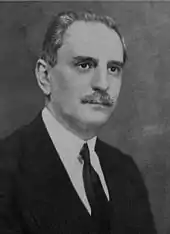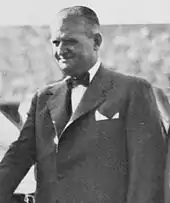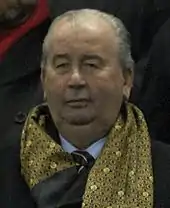Argentine Football Association
The Argentine Football Association (Spanish: Asociación del Fútbol Argentino, locally [asosjaˈsjon del ˈfutbol aɾxenˈtino], AFA) is the governing body of football in Argentina based in Buenos Aires. It organises the main divisions of Argentine league system (from Primera División to Torneo Regional Federal and Primera D), including domestic cups Copa Argentina and Supercopa Argentina. The body also manages all the Argentina national teams, including the Senior, U-20, U-17, U-15, Olympic and women's squads. Secondly, it also organizes the women's, children, youth, futsal, and other local leagues.
| CONMEBOL | |
|---|---|
.svg.png.webp) | |
| Founded | 21 February 1893 [1] |
| Headquarters | Viamonte 1366 Buenos Aires - Argentina |
| FIFA affiliation | 1 July 1912 |
| CONMEBOL affiliation | 9 July 1916 |
| President | Claudio Tapia [2] |
| Vice-President | List
|
| Website | afa.com.ar |
The AFA also organised all the Primera División championships from 1893 to 2016–17. From the 2017–18 season the "Superliga Argentina", an entity which was administrated independently and had its own statute, took over the Primera División championships.[3] Nevertheless, the Superliga was contractually linked with the main football body.[4] The last championship organised by the Superliga was 2019–20, shortly after the season ended the body was dissolved.[5]
History
The Argentine Association Football League (in English) was founded on 21 February 1893 by Alexander Watson Hutton, considered "the father" of Argentine football.[6] The Argentine Association is the oldest in South America and one of the oldest to be formed outside Europe. In 1906 Florencio Martínez de Hoz became the first Argentine-born president of the association.[7]
In 1912 the president of Gimnasia y Esgrima de Buenos Aires, Ricardo Aldao, broke up with the association establishing an own league, the "Federación Argentina de Football" which organized a parallel tournament. Some teams moved to the FAF were Gimnasia y Esgrima, Independiente, Estudiantes de La Plata and Atlanta. The league lasted until 1914 when rejoining Asociación Argentina de Football forming a unique league for the 1915 season.
The second dissident league was formed in 1919 and named "Asociación Amateurs de Football", organizing its own championships (as FAF had done) until 1926 when it merged to the official association. The dissident league included some of the most prominent teams such as River Plate, Racing, Independiente and San Lorenzo, with the exception of Boca Juniors that remained in the official "Asociación Argentina de Football".
When both leagues merged for the 1927 season, the association was again renamed to "Asociación Amateur Argentina de Football" until the professionalization of the sport in 1931 when it switched to "Liga Argentina de Football". The first round of the recently created professional championship was on 31 May 1931.[1][8]
Despite football turning professional in Argentina, some clubs wanted to remain amateur so they formed a new league, the "Asociación de Football Amateur y Profesionales", which organized a parallel tournament until 1934 when the dissident association merged with LAF on 3 November 1934 to form the "Asociación del Football Argentino" which has remained since.[1][9]
In 2015, during the presidential elections to elect a new president for the body, there were two candidates to occupy Julio Humberto Grondona's chair, Marcelo Tinelli –who wanted a change in how things were going, like eliminating corruption between some clubs and the AFA– and Luis Segura, who had taken charge after Grondona's death, with the intention of extending his mandate.
With 75 presidents of different Argentine clubs voting, on election day something went wrong when the final count resulted in a draw of 38 to 38 (76 votes in total). The explanation given was that one of the electors put a double vote and that mistake was not reported. As a result, the executive committee decided to postpone the election.[10]
After some meetings to put an end to the conflict, both candidates agreed to have another election in June 2016.[11]
In June 2016, AFA president Luis Segura was charged with "aggravated administrative fraud".[12] Segura has been replaced on an interim basis by the AFA's executive secretary, Damián Dupiellet.[13]
In 2017, the association approved the creation of a new entity, named "Superliga Argentina de Fútbol", which would take over the organization of Primera División championship.[14] The main European football leagues such as the English Premier League or the Spanish La Liga, that are organized by associations dedicated exclusively to those championships and run as separate entities from their respective National Associations, served as inspiration for the creation of the Superliga.[15]
The 2016–17 Primera División championship was the last tournament organized by the AFA. Starting with the 2017–18 season to 2019–20 season, the "Superliga Argentina", an entity administrated by itself with its own statute, organised Primera División championships.[3] In March 2020, AFA dissolved the Superliga and took over the Primera División again.[5]
Names
The body has been renamed several times since its establishment in 1893, in most of the cases translating the original English names to Spanish. The list of names is the following:[16]
- Argentine Association Football League (1893–1903) [note 1]
- Argentine Football Association (1903–1912)
- Asociación Argentina de Football (1912–1927)
- Asociación Amateur Argentina de Football (1927–1931)
- Asociación de Football Amateurs y Profesionales (1931–1934)
- Asociación del Fútbol Argentino (1934–present) [note 2]
Current staff
- President: Claudio Tapia
- Vice-presidents:
- Jorge Amor Ameal
- Rodolfo D'Onofrio
- Hugo Moyano
- Jorge Amor Ameal
- Marcelo Tinelli
- Marcelo Achile
- Guillermo Raed [2]
- General Secretary: Víctor Blanco
- Treasurer: Pablo Toviggino
- Executive Secretary: Nicolás Russo
- Men's senior head coach: Lionel Scaloni
- Men's U-20 head coach: Fernando Batista
- Women's head coach: Carlos Borrello
- National teams General Director: César Luis Menotti [18][19]
Competitions
Official Competitions
The list of official competitions organized by the Argentine Football Association since its creation in 1893 are:[20][21]
Dissident Competitions
The following table include competitions organized by dissident associations.[21]
| Name | Time | Association |
|---|---|---|
| Copa de Competencia (AAm) | 1920–1926 | Asociación Amateurs de Football |
| Copa Presidente de la Nación | 1920–1926 | Asociación Amateurs de Football [note 11] |
| Copa de Competencia (LAF) | 1932–1933 | Liga Argentina de Football |
| Copa Adrián Beccar Varela | 1932–1933 | Liga Argentina de Football |
Presidents
|
Official Association
|
Dissident Associations
|
 Alexander Watson Hutton, the first president of the Argentine Football Association in 1893  Ricardo Aldao (1918-19), had also presided dissident Federación Argentina de Football  Adrián Beccar Varela presided from 1927 to his death in 1929  Adrián C. Escobar (1939-41)  Julio Grondona had the longest tenure at the AFA, with 35 years as President of the body
| ||||||||||||||||||||||||||||||||||||||||||||||||||||||||||||||||||||||||||||||||||||||||||||||||||||||||||||||||||||||||||||||||||||||
See also
Notes
- The organisation was founded with the same name as its predecessor, the AAFL of 1891
- Translated into Spanish as "Asociación del Fútbol Argentino" in 1946
- In fact, the first official "Primera División" championship was held in 1891 and organized by a precedent association, "Argentine Association Football League", dissolved at the end of the season.[22] Since the 2017–18 season to the 2019–20 season, Primera División was organized by the Superliga Argentina de Fútbol.[3]
- The Copa Argentina was re-launched in 2011.[23]
- Contested by the champions of the Argentine Primera División and Copa Argentina
- Created and first organised by dissident Asociación Amateurs de Football and contested by representatives of regional leagues. When the AAmF folded, the AFA took over the competition, organising it until its last edition in 1989.
- Also known as "Campeonato de la República", it received the name "Copa General de División Pedro Pablo Ramírez", due to the trophy having been donated by the de facto President of Argentina, Pedro P. Ramírez
- Held once to keep league teams in readiness while the 1958 FIFA World Cup was being played
- Held once to celebrate the 100th. anniversary of the Association [24]
- Once Inicial and Final tournaments had finished, both winners played a match named "Superfinal". The Association had determined that the first edition (played in 2013) would be considered as a Primera División official title (2012–13 season), therefore Vélez Sársfield was awarded its 10th official championship after defeating Newell's Old Boys.[25] Nevertheless, from the 2014 edition it was determined that the Superfinal would not be considered as a Primera División title but a national cup.[26]
- The AFA took over the competition when the AAmF folded.
- Interventor
- Director
- Expelled by the Argentine military dictatorship
- When football became professional in Argentina, the teams that wanted to remain amateur formed this league that organized its own tournaments from 1931 to 1934, when it merged with the professional body, with all of its teams being relegated to the second division.[28]
References
- "SITIO OFICIAL DE LA ASOCIACIÓN DEL FÚTBOL ARGENTINO". Retrieved 4 March 2017.
- La nueva AFA on TyC, 18 Mar 2020
- El fútbol que viene asomando by Gustavo Veiga, Página/12, 28 Jun 2017
- La Superliga dio el puntapié inicial, Página/12, 28 Jul 2017
- Reunión clave en el fútbol argentino: Tapia recibió a los principales dirigentes de Primera con la idea de ponerle fin a la Superliga on Infobae, 26 Feb 2020
- "La historia de una casa poderosa" Archived 2015-04-13 at the Wayback Machine, Clarín, 21 Feb 2003
- "Campeones del Bicentenario", La Nación, 2010-5-18
- Diario Ole - "Bodas de Brillante"
- Historia del Fútbol Amateur en la Argentina, by Jorge Iwanczuk. Published by Autores Editores (1992) - ISBN 9504343848
- "Escándalo: la elección en la AFA salió empatada por un error y ahora Segura y Tinelli analizan unirse", La Nación, 3 Dec 2015
- "Historia de un papelón: con 75 asambleístas hubo 76 votos", Clarín, 3 Dec 2015
- "FIFA to oversee Argentinean FA after FIFA Council member charged - Sports Integrity Initiative". 27 June 2016. Retrieved 4 March 2017.
- "Ousted Argentine Football Association President attacks FIFA for taking over crisis-hit organisation". Retrieved 4 March 2017.
- La AFA aprobó la creación de la Superliga, La Nueva, 24 Feb 2017
- La creación de la Liga Argentina by Fernando Czyz on La Nación, 19 Apr 2016
- "SITIO OFICIAL DE LA ASOCIACIÓN DEL FÚTBOL ARGENTINO". Archived from the original on 4 March 2017. Retrieved 4 March 2017.
- Quién es quién en una AFA nueva, Clarín, 19 May 2020
- Qué funciones tendrá Menotti como Director de Selecciones Nacionales, Clarín, 14 Jan 2019
- César Luis Menotti será Director de Selecciones en Argentina on FIFA.com, 14 Jan 2019
- "SITIO OFICIAL DE LA ASOCIACIÓN DEL FÚTBOL ARGENTINO". Retrieved 4 March 2017.
- "Argentina - Domestic Cup History". Retrieved 4 March 2017.
- "Argentina 1891". Retrieved 4 March 2017.
- "En medio de las polémicas, Grondona lanzó la Copa Argentina" on Notio.com.ar 19 May 2011
- AFA Centenary Cup on RSSSF
- "Vélez venció a Newell's y es el Supercampeón", Clarín, 29 Dec 2013
- "La AFA homologó la final de River como una copa nacional", Cancha Llena, 28 May 2014
- Claudio Chiqui Tapia fue electo presidente casi sin oposición y comienza una nueva era, Clarín, 29 Mar 2017
- "Argentina 1934 (amateur)". Retrieved 4 March 2017.